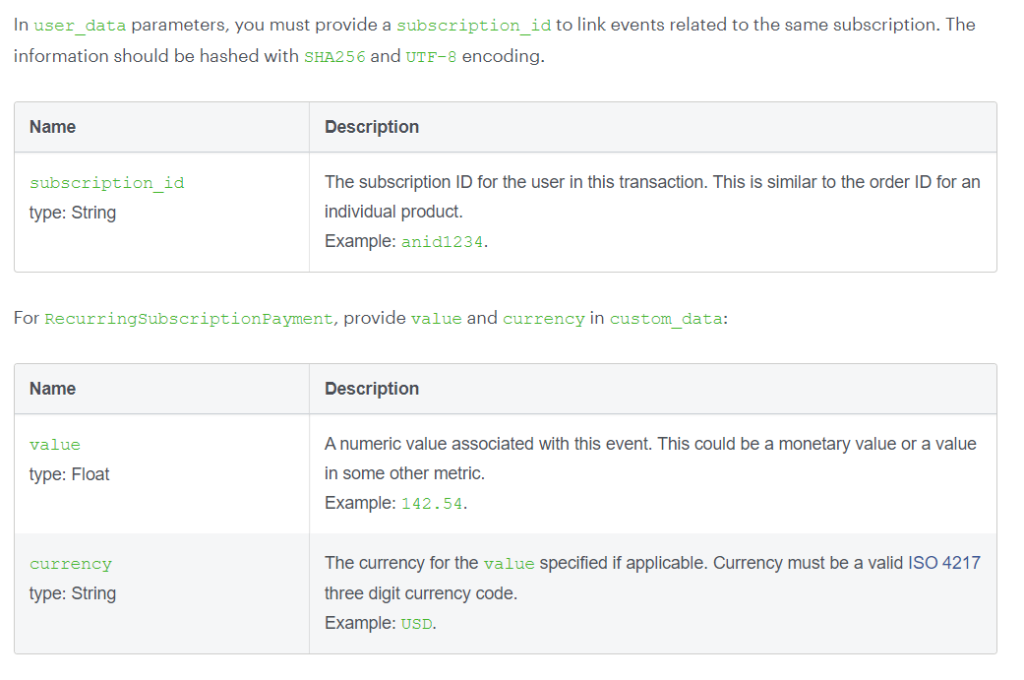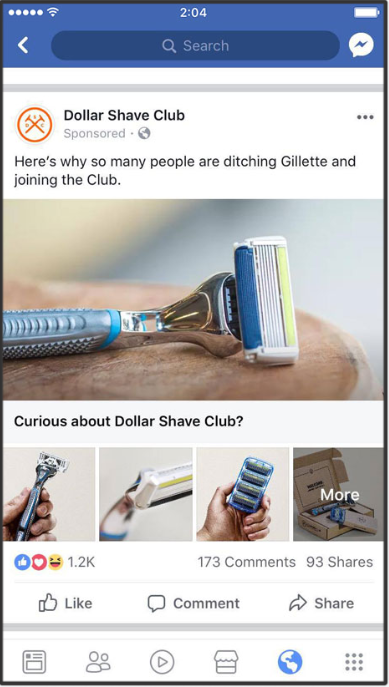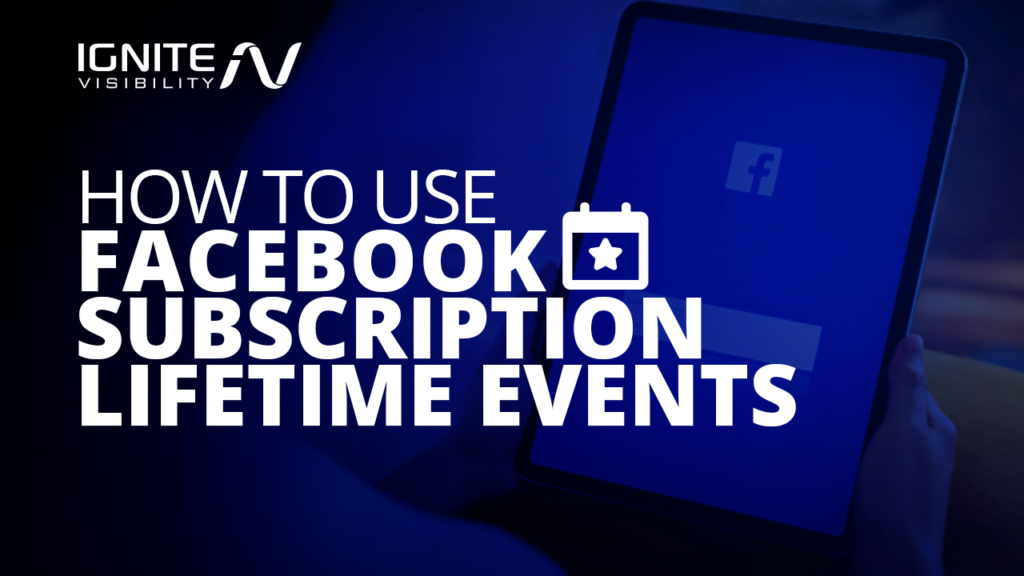Not all conversions are created equal. When you’re offering subscriptions, you’re playing the long game with your marketing efforts. Your campaigns must suit these longer purchase cycles, and that’s a tricky thing to do. Here’s how to use Facebook subscription lifecycle events to execute and measure a long-term campaign that results in more subscribers.
After learning about how to use Facebook subscription events, head to the bottom for some answers to your most frequently asked questions.
Marketing for Subscriptions VS One-Time Purchases
According to Quickbooks, businesses with subscription-based offerings earn 217% more profit than those who only offer one-time purchases over the course of their lifetime. It makes total sense you’d want to delve into the subscription industry. But if your product or service requires a recurring payment, the fact of the matter is your marketing efforts are going to be a bit different from the one-and-done kind of sales.
Commonly, you’ll see subscription-based businesses attempt to generate leads in the form of free trials. Having the customer sign up for the free trial is the first conversion while getting them to become a paid user is the primary conversion.
As you can imagine, the free trial tactic doesn’t work for one-time purchases. If you translated it, you’d be giving away your offering for free. Some brands that sell goods do this in the form of free samples, though.
Another marketing technique for subscription models includes giving a discount for the first month. I commonly hear this while listening to podcasts. The hosts will share their advertisements for things like meal delivery services and spew a discount code for 10% off your first order. This method also uses dual conversions, as you want your subscriber to move on to paying full price in due time. One study shared that B2B business customers who started their subscription off with a coupon stayed for 22% longer than those who didn’t.
The CARE methodology is another big one for subscription lifecycle marketing. This calls for:
- Content that educates, informs and inspires
- Automation to personalize at scale
- Relevancy to create a dialogue that’s rooted in data
- Engagement that promotes dialogue between you and your subscribers
Sharing these marketing techniques for subscription-based businesses just hammers home the fact that the subscription lifecycle is an extensive process that takes a lot of work. Using Facebook subscription lifecycle events to track your leads and optimize your ad campaigns can be a helpful tool.
How Facebook Subscription Events Can Guide You In Your Marketing Journey
Facebook subscription lifecycle events are geared toward the longer marketing processes of subscription-based businesses. For brands who advertise through Facebook campaigns in search of subscribers, they primarily help in two ways:
- Measure: In order to understand how your ad campaigns are performing, you’ll need metrics that cater to subscription companies. Facebook offers a few key metrics specifically tailored to subscriptions, as well as other conversion events (AKA customer actions) that these businesses will also find relevant (you can learn more about the Facebook pixel here).
- Execute: With these metrics in mind, you can adjust existing campaigns and tailor future campaigns to better suit your needs. Tweaking your content can improve your conversion rates by delivering your subscribers (or future subscribers) what they need to make that final leap.
If you’re a business with a subscription model, learning the ins and outs of Facebook subscription events — and actually putting them to use — can propel your campaign’s conversion rate through the roof. All I can say is this: I hope you’re ready for an influx.
What Metrics Can You Report with Facebook Subscription Lifecycle Events?
There are three main metrics that you can report using the subscription lifecycle events:
1.Recurring Subscription Payments
This relates to the number of recurring subscription payments you land as a result of your Facebook ad campaign. This metric is based on the data you’ve collected using Facebook’s various Business Tools.
According to Facebook, “This metric is attributed to an initial subscribe event and may increase over time if recurring payments continue to be received after your ad campaigns end.”
This metric can be further broken down into two nuanced values:
- Website Recurring Subscription Payments: Any of the specified conversions that occurred on your website (either via a desktop or on a mobile device’s desktop mode)
- App Recurring Subscription Payments: Any of the specified conversions that occurred on your business’ smartphone app
Knowing the intricacies of your recurring subscription payment conversions can help you determine whether to focus your ads on mobile or desktop, ultimately making way for higher subscription rates.
2. Canceled Subscriptions
Sure, it’s a bummer — but you can’t talk about subscription marketing without looking at canceled subscription rates. This metric determines the number of canceled subscriptions, based on any information garnered through your various Facebook Business Tools.
Similar to the previous metric, Facebook notes that this value may increase over time if you continue to receive canceled subscriptions after your ad campaign has ended.
This metric can be further broken down into two nuanced values:
- Website Canceled Subscriptions: Any of the specified conversions that occurred on your website (either via a desktop or on a mobile device’s desktop mode)
- App Canceled Subscriptions: Any of the specified conversions that occurred on your business’ smartphone app
Again, it’s crucial to know where your canceled subscriptions are coming from. This can help you maneuver your marketing in the right direction to minimize this metric.
3. Recurring Subscription Payment Conversion Value
This metric comes from the following equation:
Number of all recurring subscription payments + initial subscription sign-up payments
These values are received by Facebook from your server based on your coded pixel.
Like the advertising elite it is (hey, Facebook does garner 98.5% of its global revenue from advertising alone), these metrics for subscription-based businesses aren’t dished out publicly. You need to contact your Facebook representative to gain access, but don’t let that deter you! As the old adage goes, you gotta’ fight for your right to…convert?
It’s worth noting that you can also use other events (more on that in the FAQ!) garnered by your Facebook pixel that may be relevant for your subscription-model business. Just because you offer a subscription product or service instead of a one-time purchase doesn’t mean that other conversions aren’t important for your Facebook ad marketing technique.
Our advice: Make the most of those metrics and lift your brand to a new level.
Getting Started with Executing and Measuring Your Subscription Ad Campaign
First thing’s first: You need to develop a subscription ad campaign. Naturally, this campaign will be rooted in audience targeting via demographics and psychographics. But your pre-campaign measurements can only tell you so much. Once your ads are in the jungle, tracking conversion data for your subscription business will help you develop more nuanced campaigns in the future — or adjust ongoing campaigns on an as-needed basis.
Be sure to install your Facebook pixel on your subscription landing page to be able to track any considerations and conversions that result from your advertisements. There’s nothing like real-time results to really hone your campaigns.
What Prerequisites Do You Need?
Unlike the conversions API for brick-and-mortar merchants, the prerequisite for setting up Facebook subscription lifecycle events is limited to just one.
As a marketer for a subscription business, you must specify the subscription ID code in your pixel.
Code: subscription_id: ‘your code’

Facebook subscription ID example
This allows you to match post-conversion events with initial standard events (head to the FAQ for more on the different types of events). Once you implement the subscription ID code into your pixel, you’ll be able to link consumer actions and determine which subscription events correlate with your ad campaign.
For more details on how to implement parameters for the events, you want to track, visit the Facebook for Developers guide on parameters.
Know These Required Parameters for Facebook Subscription Events
Similar to the conversions API, you need to know some required parameters for your Facebook subscription events setup.
The required parameters for measuring subscription conversions are the subscription ID and recurring subscription payment.
recommended internal link

Facebook subscription events required parameters
How to Note Canceled & Reactivated Subscriptions
In some instances, a user might cancel their subscription only to reactivate it at a later date. If this happens, good for you! Your marketing approach is working, even if you hit a bump in the road.
When the user cancels their subscription, you send a “CancelSubscription” event through Facebook. This stops the platform from mapping that Subscription ID. When the user reactivates their subscription later on, you send a new “Subscribe” or “StartTrial” event. In this instance, you can use a new Subscription ID, or keep the original one.
Some Facebook marketers for subscription businesses note that using “Subscribe” instead of “StartTrial” events results in better metrics. Facebook’s software is set up to optimize for new purchases more than freebie grabs. You’ll have to try this out for yourself, but it’s worth keeping an eye on.
A Broader Picture: Weaving Facebook Subscription Events Into Your Overall Conversions Analysis
Subscriptions may be your brand’s ultimate conversion, but that doesn’t mean they represent the whole picture. You’ll want to integrate the metrics that result from tracking these events into other metrics, like free trials to paid subscriptions, clickthrough rates, bounce rates, content engagement and more.
This is especially crucial because of the nature of subscription lifecycle marketing. We’re talking longer purchase cycles, which means putting a higher emphasis on the smaller conversions and working to keep those potential customers intrigued.
Real-Time Effects of Tracking Facebook Subscription Events
It’s easy enough to go through the motions and learn how to use Facebook subscription lifecycle events, but sometimes you need a little inspo. Here are some success stories for subscription-based businesses who used their Facebook ad campaigns to bump up their conversion rates.
Dollar Shave Club used photo-based Facebook ads with simple captions to capture their audience’s attention. Their objective was straightforward: Get new members. Ultimately, they earned a 1.5X increase in subscriptions. Because of their advertising success, they enjoyed a 30% decrease in the cost per subscription when compared with regular link ads. Throughout the campaign, the Club reached a whopping 1.6 million users.

Dollar Shave Club advertisement
Hunt a Killer is a role-playing game bent on murder mysteries. Obviously, the offering is very niche, but you’d be surprised how many true crime junkies there are in the world. Their goal? Use Facebook ads to find new players and boost subscriptions as a direct result of their campaign. In the end, the case never had a chance to go cold. They increased their subscribers by 4.9X, resulting in a 2X increase in total active subscribers. This led to a 28% cheaper cost per subscriber when compared with the previous two months.
Pure Barre Studio Chicago Region is a fitness studio franchise in — you guessed it — Chicago. In this campaign, their Facebook ad shared news of an open house, but they used this platform to find leads for a free class (AKA free trial) and ultimately a membership subscription offer. Just in the first month, Pure Barre earned 724 new leads (51% of which actually visited the studio in person). An impressive 33% of those leads ended up purchasing a subscription-based membership.
Catering to the Unique Needs of Subscription Marketers
Subscription marketing is a unique game, so it only makes sense that Facebook’s robust advertising platform would cater to this. For companies who rely on memberships for products or services, using tailored conversion metrics is a sound solution. Knowing how to use Facebook subscription lifecycle events is your pathway to one heck of an optimized Facebook marketing campaign.
FAQ
1.What is a Facebook event?
Short answer: An action a consumer takes as a result of seeing your Facebook ad.
Regardless of what you’re measuring, an event is an action your customer chooses to take after encountering your ad. This action could be in the awareness, consideration or conversion stage. For businesses with subscription models, key events include recurring subscription payments, canceled subscriptions and more.
2. What are the different types of events?
Here’s a list of Facebook standard events. You can also use custom events to better navigate your audience’s buying journey.
3. How do Facebook subscription lifecycle events help marketers for subscription-based brands?
Short answer: Measure & execute.
By quantifying the effects of your Facebook ad campaign, you’re able to optimize existing ads and better execute future campaigns.
